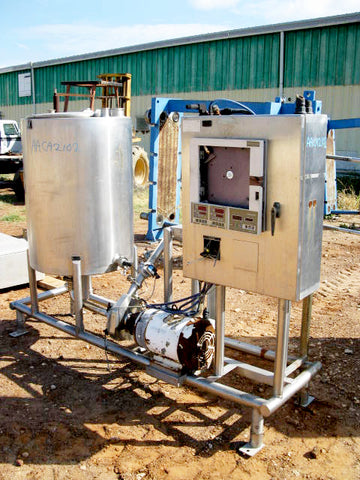Food processing equipment can get dirty during production, and even the tiniest splatter of spilled ingredients can leave a biofilm that pathogens love to colonize. Regulations for processing sensitive products such as food and pharmaceuticals require periodic thorough washing and sanitizing. Some equipment can be moved to a central washing facility. Other machinery must be cleaned in place using portable specialized washing equipment. High-pressure cleaning is used with water and cleaning chemicals.
So what is a washdown exactly? It's as basic as it sounds, it's the process of cleaning or washing a surface for appearance, sanitation, or removal of contamination. For machines on the production floor that are too large to move, you’ll need to do a washdown in place. There is also automatic cleaning. Which is the cleaning of industrial equipment often carried out by clean-in-place (CIP) and/or steam-in-place (SIP) operations. CIP systems often make use of programmable logic controllers and SCADA software.
Genemco: Stainless steel CIP System - 88 Gallons (Stock #AACA2102.9a)
Below are the stages of a washdown and its potential pitfalls according to Grainger KnowHow...
Stages of the Washdown
The washdown procedure can be broken down into six basic stages:
- Prewash: A prewash to remove caked-on grime will prepare the surface for sanitation. The prewash should remove all visible soiling from the machine, leaving only thin biofilms that can be broken down by detergent in the next step.
- Soak: Next, the machinery is sprayed from top to bottom with a foaming detergent, coating every surface in a solution that will dissolve oil and sugar residues.
- Scrub: Mechanical action is necessary to ensure the removal of all traces of organic matter. Soft-bristled brushes are gentle on equipment and can squeeze into tight corners, but stiffer brushes may do a better job of removing stubborn materials.
- Sanitize: The cleaned surface is now ready for a sanitizing agent, which will kill any lingering pathogens. Many quat-based sanitizers are designed to be “no-rinse,” and can be left to dry on the equipment.
- Dry: Pockets of moisture are not compatible with a sanitary environment. Bacteria thrive in puddles and pools, so your washdown should conclude with the equipment in a fully dried state.
- Verify: Finally, you will need to verify that the washdown has successfully removed all traces of food residue. Whenever possible, visual inspection should be complemented with an ATP laboratory test, which will verify that no organic material remains on the machine’s surface.
Dodging Washdown’s Pitfalls
Improper washdown procedures can actually create new contamination hazards. When planning your washdown, watch out for the following pitfalls:
- Equipment Fatigue: Cleaning agents and mechanical scrubbing will gradually wear down production equipment, creating permeable surfaces that are impossible to thoroughly clean. Look for scratches, pitting and discoloration, all of which can indicate the formation of crevices where bacteria can hide.
- Turning to Scouring Pads: It’s tempting to use scouring pads to mechanically remove grime. Unfortunately, the pads’ fibers shred at a microscopic level as they clean, which introduces specks of foreign material into production equipment.
- Cranking Up the Pressure: A high-pressure spray will quickly blast off food residue, but an intense spray can splatter—and even aerosolize—harmful bacteria like listeria. The droplets from a high pressure spray can then condense onto equipment that has already been sanitized. This is why you should always use the lowest pressure possible in your washdown.
- Dry Detergent: Detergent only works when it’s wet, so you need to be careful not to allow foaming agents to dry. A dried detergent can form a soap film that retains organic matter, creating a contamination hazard.
- Leaks and Pools: The fittings and couplings on washdown hoses can drip, leaving pools of water and an unhygienic floor. Watch carefully for drips, and be sure your post-washdown inspection includes checking underneath machinery for pooled water.
Carefully consider every element of your washdown procedure. If you start with the basics and stick to a plan, you can avoid the common pitfalls.
For CIP and other food processing cleaning equipment visit genemco.
For more information on washdownds visit Grainger KnowHow and Harpak Ulma.















